A Study on the Problems Faced by Farmers in India: Solutions
VerifiedAdded on 2021/02/21
|19
|5227
|101
Report
AI Summary
This report presents a comprehensive analysis of the problems faced by farmers in India, exploring various aspects from the initial research design proposal to the final data analysis and ethical considerations. The report begins with an overview of the importance of agriculture in the Indian economy and highlights the various challenges farmers face, including credit access, irrigation techniques, storage facilities, and market access. The research methodology section details the qualitative approach, interpretivism philosophy, inductive research approach, and descriptive research design used. Data collection methods, including primary and secondary sources, are discussed, along with the sampling technique used to gather information from 50 respondents. The data analysis section outlines the statistical techniques to be used for interpreting the collected data, and the ethical considerations, referencing, and presentation guidelines are also addressed. The report aims to provide a detailed understanding of the challenges, solutions, and the impact of these problems on the Indian agricultural sector.
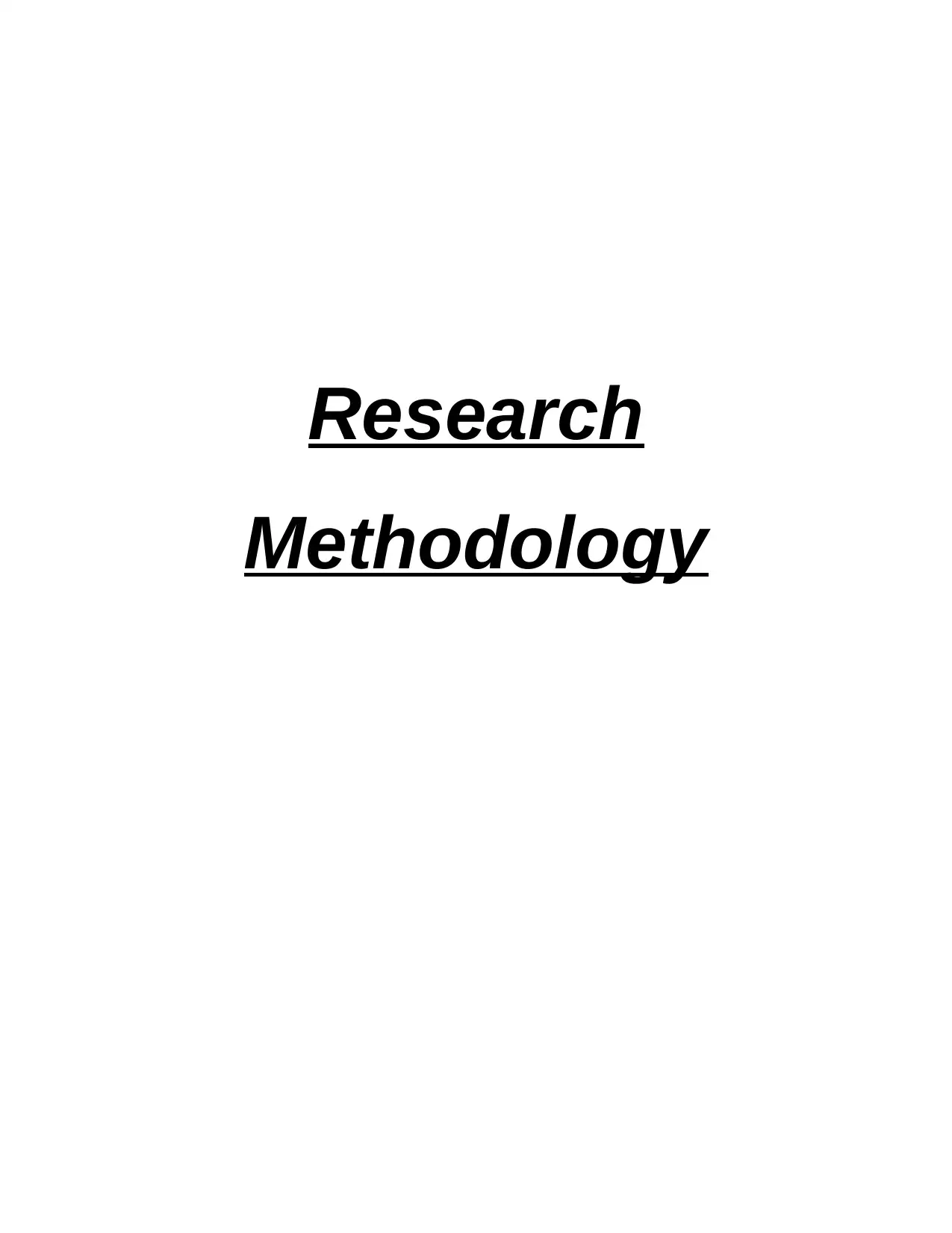
Research
Methodology
Methodology
Paraphrase This Document
Need a fresh take? Get an instant paraphrase of this document with our AI Paraphraser

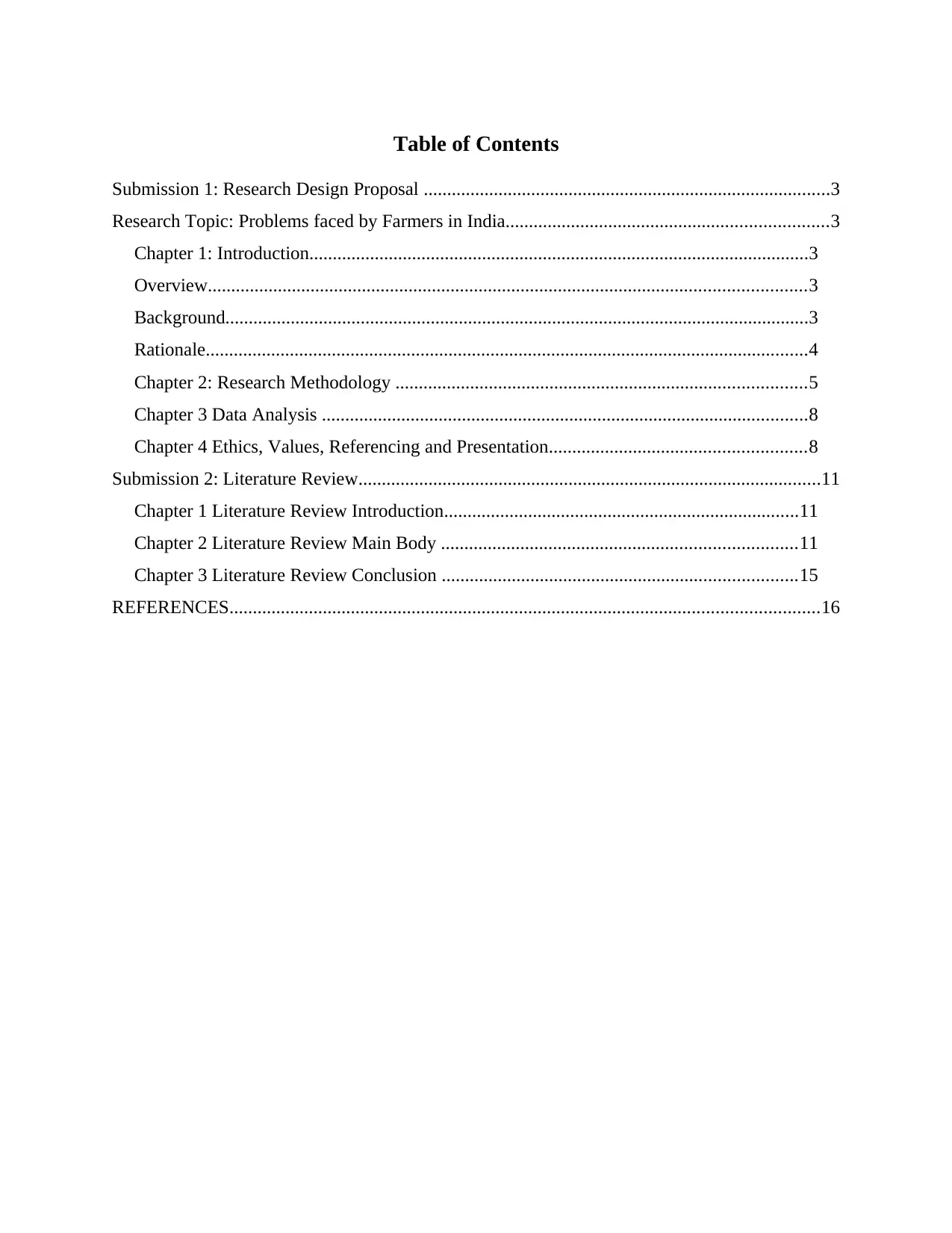
Table of Contents
Submission 1: Research Design Proposal .......................................................................................3
Research Topic: Problems faced by Farmers in India.....................................................................3
Chapter 1: Introduction...........................................................................................................3
Overview................................................................................................................................3
Background.............................................................................................................................3
Rationale.................................................................................................................................4
Chapter 2: Research Methodology ........................................................................................5
Chapter 3 Data Analysis ........................................................................................................8
Chapter 4 Ethics, Values, Referencing and Presentation.......................................................8
Submission 2: Literature Review...................................................................................................11
Chapter 1 Literature Review Introduction............................................................................11
Chapter 2 Literature Review Main Body ............................................................................11
Chapter 3 Literature Review Conclusion ............................................................................15
REFERENCES..............................................................................................................................16
Submission 1: Research Design Proposal .......................................................................................3
Research Topic: Problems faced by Farmers in India.....................................................................3
Chapter 1: Introduction...........................................................................................................3
Overview................................................................................................................................3
Background.............................................................................................................................3
Rationale.................................................................................................................................4
Chapter 2: Research Methodology ........................................................................................5
Chapter 3 Data Analysis ........................................................................................................8
Chapter 4 Ethics, Values, Referencing and Presentation.......................................................8
Submission 2: Literature Review...................................................................................................11
Chapter 1 Literature Review Introduction............................................................................11
Chapter 2 Literature Review Main Body ............................................................................11
Chapter 3 Literature Review Conclusion ............................................................................15
REFERENCES..............................................................................................................................16
⊘ This is a preview!⊘
Do you want full access?
Subscribe today to unlock all pages.

Trusted by 1+ million students worldwide
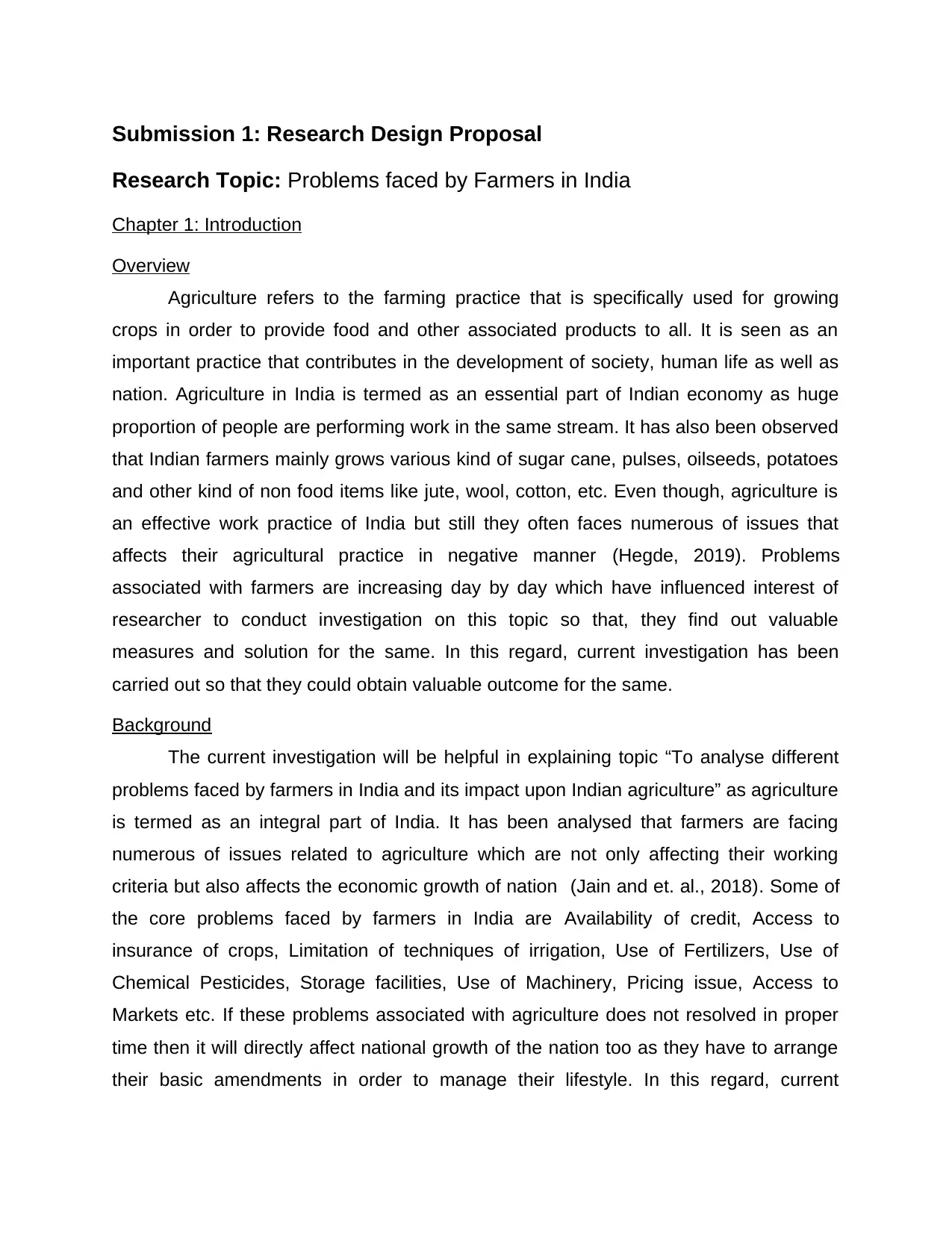
Submission 1: Research Design Proposal
Research Topic: Problems faced by Farmers in India
Chapter 1: Introduction
Overview
Agriculture refers to the farming practice that is specifically used for growing
crops in order to provide food and other associated products to all. It is seen as an
important practice that contributes in the development of society, human life as well as
nation. Agriculture in India is termed as an essential part of Indian economy as huge
proportion of people are performing work in the same stream. It has also been observed
that Indian farmers mainly grows various kind of sugar cane, pulses, oilseeds, potatoes
and other kind of non food items like jute, wool, cotton, etc. Even though, agriculture is
an effective work practice of India but still they often faces numerous of issues that
affects their agricultural practice in negative manner (Hegde, 2019). Problems
associated with farmers are increasing day by day which have influenced interest of
researcher to conduct investigation on this topic so that, they find out valuable
measures and solution for the same. In this regard, current investigation has been
carried out so that they could obtain valuable outcome for the same.
Background
The current investigation will be helpful in explaining topic “To analyse different
problems faced by farmers in India and its impact upon Indian agriculture” as agriculture
is termed as an integral part of India. It has been analysed that farmers are facing
numerous of issues related to agriculture which are not only affecting their working
criteria but also affects the economic growth of nation (Jain and et. al., 2018). Some of
the core problems faced by farmers in India are Availability of credit, Access to
insurance of crops, Limitation of techniques of irrigation, Use of Fertilizers, Use of
Chemical Pesticides, Storage facilities, Use of Machinery, Pricing issue, Access to
Markets etc. If these problems associated with agriculture does not resolved in proper
time then it will directly affect national growth of the nation too as they have to arrange
their basic amendments in order to manage their lifestyle. In this regard, current
Research Topic: Problems faced by Farmers in India
Chapter 1: Introduction
Overview
Agriculture refers to the farming practice that is specifically used for growing
crops in order to provide food and other associated products to all. It is seen as an
important practice that contributes in the development of society, human life as well as
nation. Agriculture in India is termed as an essential part of Indian economy as huge
proportion of people are performing work in the same stream. It has also been observed
that Indian farmers mainly grows various kind of sugar cane, pulses, oilseeds, potatoes
and other kind of non food items like jute, wool, cotton, etc. Even though, agriculture is
an effective work practice of India but still they often faces numerous of issues that
affects their agricultural practice in negative manner (Hegde, 2019). Problems
associated with farmers are increasing day by day which have influenced interest of
researcher to conduct investigation on this topic so that, they find out valuable
measures and solution for the same. In this regard, current investigation has been
carried out so that they could obtain valuable outcome for the same.
Background
The current investigation will be helpful in explaining topic “To analyse different
problems faced by farmers in India and its impact upon Indian agriculture” as agriculture
is termed as an integral part of India. It has been analysed that farmers are facing
numerous of issues related to agriculture which are not only affecting their working
criteria but also affects the economic growth of nation (Jain and et. al., 2018). Some of
the core problems faced by farmers in India are Availability of credit, Access to
insurance of crops, Limitation of techniques of irrigation, Use of Fertilizers, Use of
Chemical Pesticides, Storage facilities, Use of Machinery, Pricing issue, Access to
Markets etc. If these problems associated with agriculture does not resolved in proper
time then it will directly affect national growth of the nation too as they have to arrange
their basic amendments in order to manage their lifestyle. In this regard, current
Paraphrase This Document
Need a fresh take? Get an instant paraphrase of this document with our AI Paraphraser
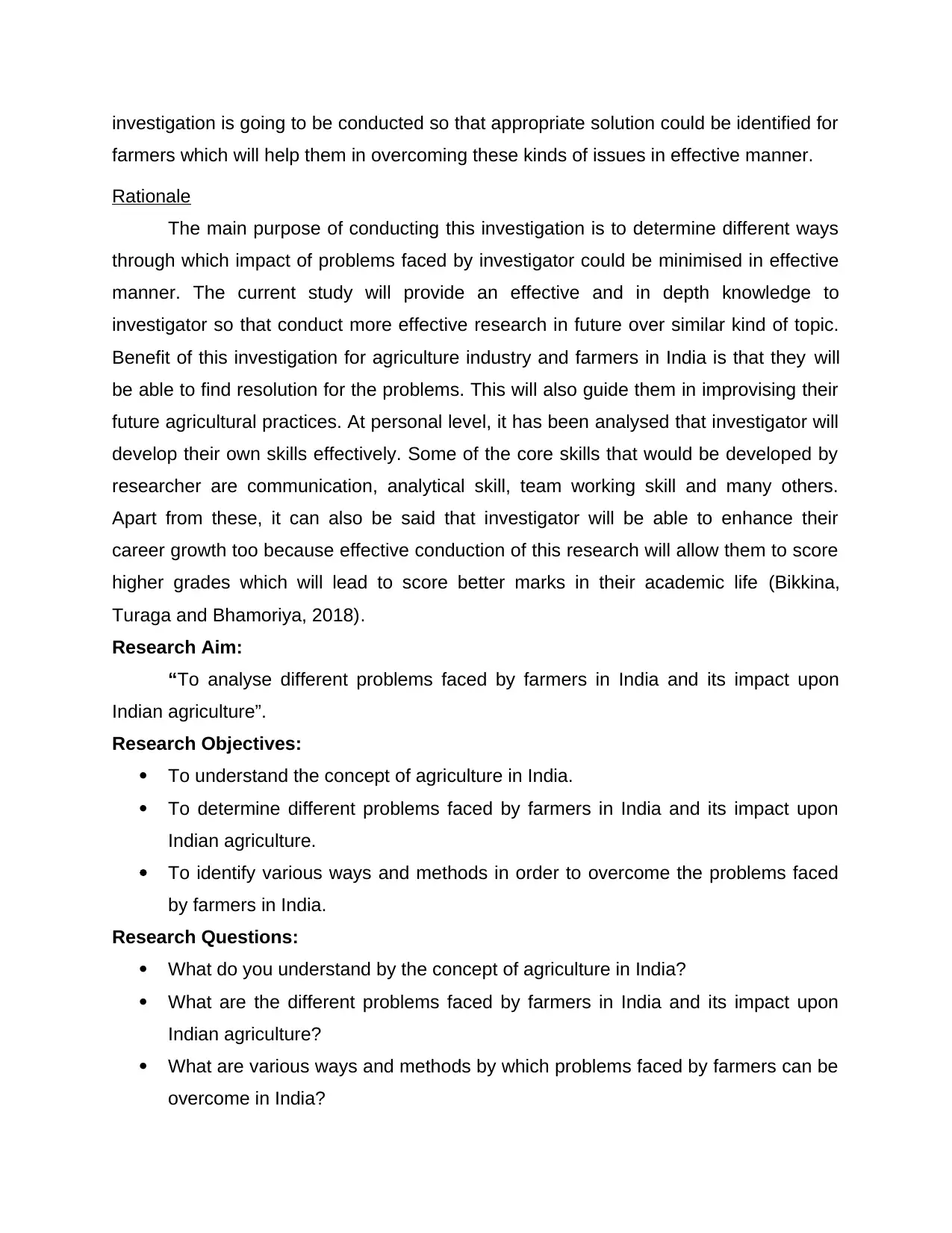
investigation is going to be conducted so that appropriate solution could be identified for
farmers which will help them in overcoming these kinds of issues in effective manner.
Rationale
The main purpose of conducting this investigation is to determine different ways
through which impact of problems faced by investigator could be minimised in effective
manner. The current study will provide an effective and in depth knowledge to
investigator so that conduct more effective research in future over similar kind of topic.
Benefit of this investigation for agriculture industry and farmers in India is that they will
be able to find resolution for the problems. This will also guide them in improvising their
future agricultural practices. At personal level, it has been analysed that investigator will
develop their own skills effectively. Some of the core skills that would be developed by
researcher are communication, analytical skill, team working skill and many others.
Apart from these, it can also be said that investigator will be able to enhance their
career growth too because effective conduction of this research will allow them to score
higher grades which will lead to score better marks in their academic life (Bikkina,
Turaga and Bhamoriya, 2018).
Research Aim:
“To analyse different problems faced by farmers in India and its impact upon
Indian agriculture”.
Research Objectives:
To understand the concept of agriculture in India.
To determine different problems faced by farmers in India and its impact upon
Indian agriculture.
To identify various ways and methods in order to overcome the problems faced
by farmers in India.
Research Questions:
What do you understand by the concept of agriculture in India?
What are the different problems faced by farmers in India and its impact upon
Indian agriculture?
What are various ways and methods by which problems faced by farmers can be
overcome in India?
farmers which will help them in overcoming these kinds of issues in effective manner.
Rationale
The main purpose of conducting this investigation is to determine different ways
through which impact of problems faced by investigator could be minimised in effective
manner. The current study will provide an effective and in depth knowledge to
investigator so that conduct more effective research in future over similar kind of topic.
Benefit of this investigation for agriculture industry and farmers in India is that they will
be able to find resolution for the problems. This will also guide them in improvising their
future agricultural practices. At personal level, it has been analysed that investigator will
develop their own skills effectively. Some of the core skills that would be developed by
researcher are communication, analytical skill, team working skill and many others.
Apart from these, it can also be said that investigator will be able to enhance their
career growth too because effective conduction of this research will allow them to score
higher grades which will lead to score better marks in their academic life (Bikkina,
Turaga and Bhamoriya, 2018).
Research Aim:
“To analyse different problems faced by farmers in India and its impact upon
Indian agriculture”.
Research Objectives:
To understand the concept of agriculture in India.
To determine different problems faced by farmers in India and its impact upon
Indian agriculture.
To identify various ways and methods in order to overcome the problems faced
by farmers in India.
Research Questions:
What do you understand by the concept of agriculture in India?
What are the different problems faced by farmers in India and its impact upon
Indian agriculture?
What are various ways and methods by which problems faced by farmers can be
overcome in India?
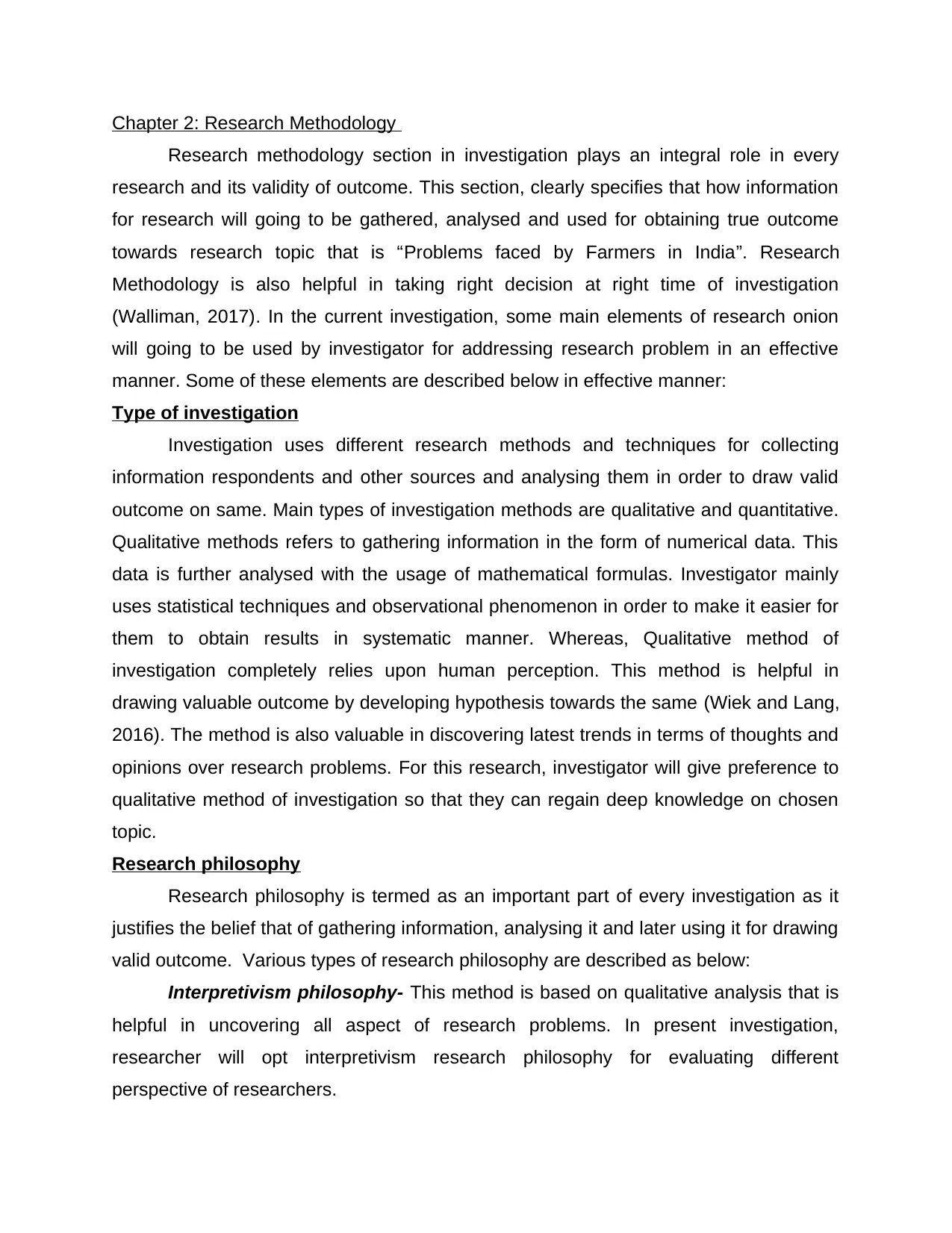
Chapter 2: Research Methodology
Research methodology section in investigation plays an integral role in every
research and its validity of outcome. This section, clearly specifies that how information
for research will going to be gathered, analysed and used for obtaining true outcome
towards research topic that is “Problems faced by Farmers in India”. Research
Methodology is also helpful in taking right decision at right time of investigation
(Walliman, 2017). In the current investigation, some main elements of research onion
will going to be used by investigator for addressing research problem in an effective
manner. Some of these elements are described below in effective manner:
Type of investigation
Investigation uses different research methods and techniques for collecting
information respondents and other sources and analysing them in order to draw valid
outcome on same. Main types of investigation methods are qualitative and quantitative.
Qualitative methods refers to gathering information in the form of numerical data. This
data is further analysed with the usage of mathematical formulas. Investigator mainly
uses statistical techniques and observational phenomenon in order to make it easier for
them to obtain results in systematic manner. Whereas, Qualitative method of
investigation completely relies upon human perception. This method is helpful in
drawing valuable outcome by developing hypothesis towards the same (Wiek and Lang,
2016). The method is also valuable in discovering latest trends in terms of thoughts and
opinions over research problems. For this research, investigator will give preference to
qualitative method of investigation so that they can regain deep knowledge on chosen
topic.
Research philosophy
Research philosophy is termed as an important part of every investigation as it
justifies the belief that of gathering information, analysing it and later using it for drawing
valid outcome. Various types of research philosophy are described as below:
Interpretivism philosophy- This method is based on qualitative analysis that is
helpful in uncovering all aspect of research problems. In present investigation,
researcher will opt interpretivism research philosophy for evaluating different
perspective of researchers.
Research methodology section in investigation plays an integral role in every
research and its validity of outcome. This section, clearly specifies that how information
for research will going to be gathered, analysed and used for obtaining true outcome
towards research topic that is “Problems faced by Farmers in India”. Research
Methodology is also helpful in taking right decision at right time of investigation
(Walliman, 2017). In the current investigation, some main elements of research onion
will going to be used by investigator for addressing research problem in an effective
manner. Some of these elements are described below in effective manner:
Type of investigation
Investigation uses different research methods and techniques for collecting
information respondents and other sources and analysing them in order to draw valid
outcome on same. Main types of investigation methods are qualitative and quantitative.
Qualitative methods refers to gathering information in the form of numerical data. This
data is further analysed with the usage of mathematical formulas. Investigator mainly
uses statistical techniques and observational phenomenon in order to make it easier for
them to obtain results in systematic manner. Whereas, Qualitative method of
investigation completely relies upon human perception. This method is helpful in
drawing valuable outcome by developing hypothesis towards the same (Wiek and Lang,
2016). The method is also valuable in discovering latest trends in terms of thoughts and
opinions over research problems. For this research, investigator will give preference to
qualitative method of investigation so that they can regain deep knowledge on chosen
topic.
Research philosophy
Research philosophy is termed as an important part of every investigation as it
justifies the belief that of gathering information, analysing it and later using it for drawing
valid outcome. Various types of research philosophy are described as below:
Interpretivism philosophy- This method is based on qualitative analysis that is
helpful in uncovering all aspect of research problems. In present investigation,
researcher will opt interpretivism research philosophy for evaluating different
perspective of researchers.
⊘ This is a preview!⊘
Do you want full access?
Subscribe today to unlock all pages.

Trusted by 1+ million students worldwide
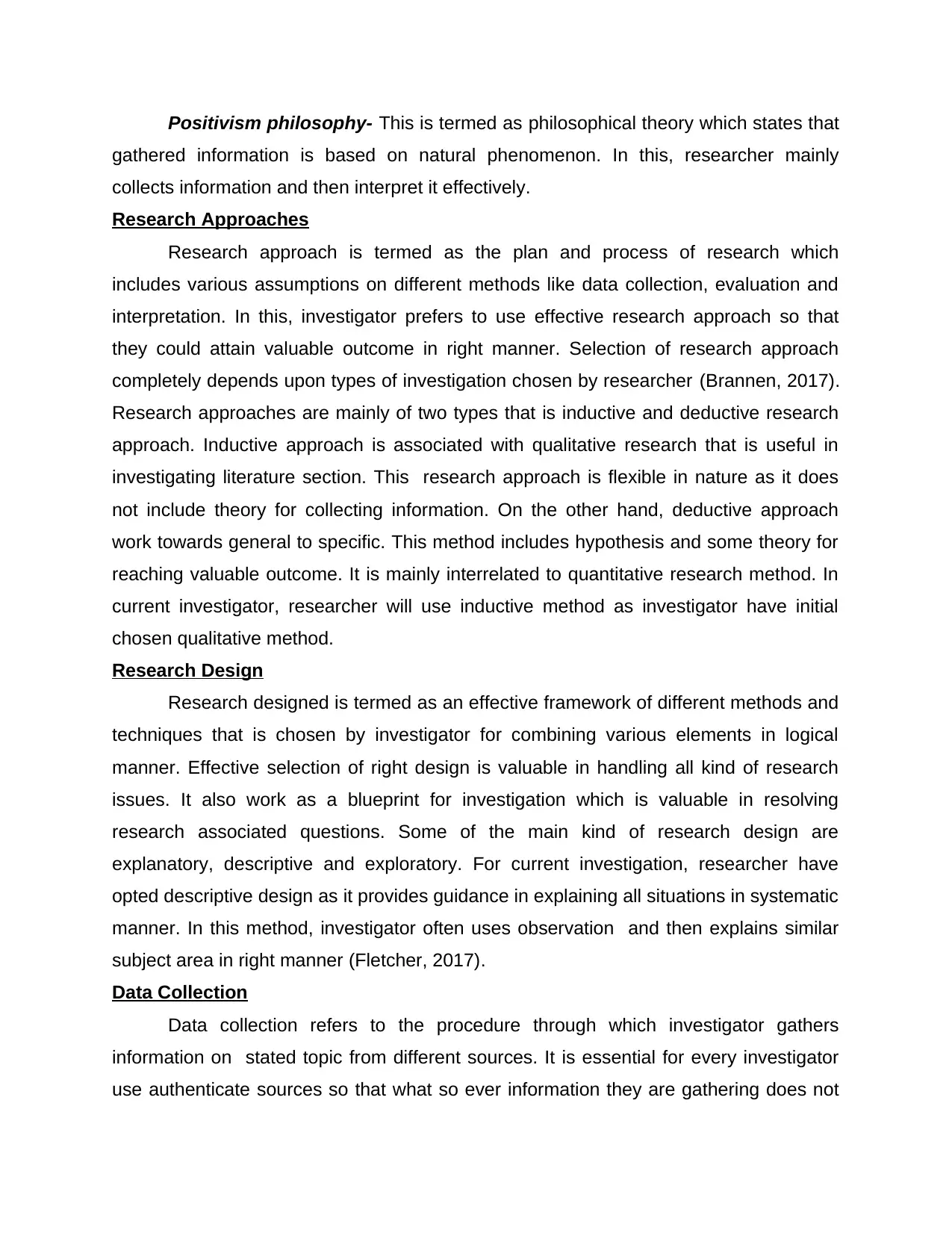
Positivism philosophy- This is termed as philosophical theory which states that
gathered information is based on natural phenomenon. In this, researcher mainly
collects information and then interpret it effectively.
Research Approaches
Research approach is termed as the plan and process of research which
includes various assumptions on different methods like data collection, evaluation and
interpretation. In this, investigator prefers to use effective research approach so that
they could attain valuable outcome in right manner. Selection of research approach
completely depends upon types of investigation chosen by researcher (Brannen, 2017).
Research approaches are mainly of two types that is inductive and deductive research
approach. Inductive approach is associated with qualitative research that is useful in
investigating literature section. This research approach is flexible in nature as it does
not include theory for collecting information. On the other hand, deductive approach
work towards general to specific. This method includes hypothesis and some theory for
reaching valuable outcome. It is mainly interrelated to quantitative research method. In
current investigator, researcher will use inductive method as investigator have initial
chosen qualitative method.
Research Design
Research designed is termed as an effective framework of different methods and
techniques that is chosen by investigator for combining various elements in logical
manner. Effective selection of right design is valuable in handling all kind of research
issues. It also work as a blueprint for investigation which is valuable in resolving
research associated questions. Some of the main kind of research design are
explanatory, descriptive and exploratory. For current investigation, researcher have
opted descriptive design as it provides guidance in explaining all situations in systematic
manner. In this method, investigator often uses observation and then explains similar
subject area in right manner (Fletcher, 2017).
Data Collection
Data collection refers to the procedure through which investigator gathers
information on stated topic from different sources. It is essential for every investigator
use authenticate sources so that what so ever information they are gathering does not
gathered information is based on natural phenomenon. In this, researcher mainly
collects information and then interpret it effectively.
Research Approaches
Research approach is termed as the plan and process of research which
includes various assumptions on different methods like data collection, evaluation and
interpretation. In this, investigator prefers to use effective research approach so that
they could attain valuable outcome in right manner. Selection of research approach
completely depends upon types of investigation chosen by researcher (Brannen, 2017).
Research approaches are mainly of two types that is inductive and deductive research
approach. Inductive approach is associated with qualitative research that is useful in
investigating literature section. This research approach is flexible in nature as it does
not include theory for collecting information. On the other hand, deductive approach
work towards general to specific. This method includes hypothesis and some theory for
reaching valuable outcome. It is mainly interrelated to quantitative research method. In
current investigator, researcher will use inductive method as investigator have initial
chosen qualitative method.
Research Design
Research designed is termed as an effective framework of different methods and
techniques that is chosen by investigator for combining various elements in logical
manner. Effective selection of right design is valuable in handling all kind of research
issues. It also work as a blueprint for investigation which is valuable in resolving
research associated questions. Some of the main kind of research design are
explanatory, descriptive and exploratory. For current investigation, researcher have
opted descriptive design as it provides guidance in explaining all situations in systematic
manner. In this method, investigator often uses observation and then explains similar
subject area in right manner (Fletcher, 2017).
Data Collection
Data collection refers to the procedure through which investigator gathers
information on stated topic from different sources. It is essential for every investigator
use authenticate sources so that what so ever information they are gathering does not
Paraphrase This Document
Need a fresh take? Get an instant paraphrase of this document with our AI Paraphraser
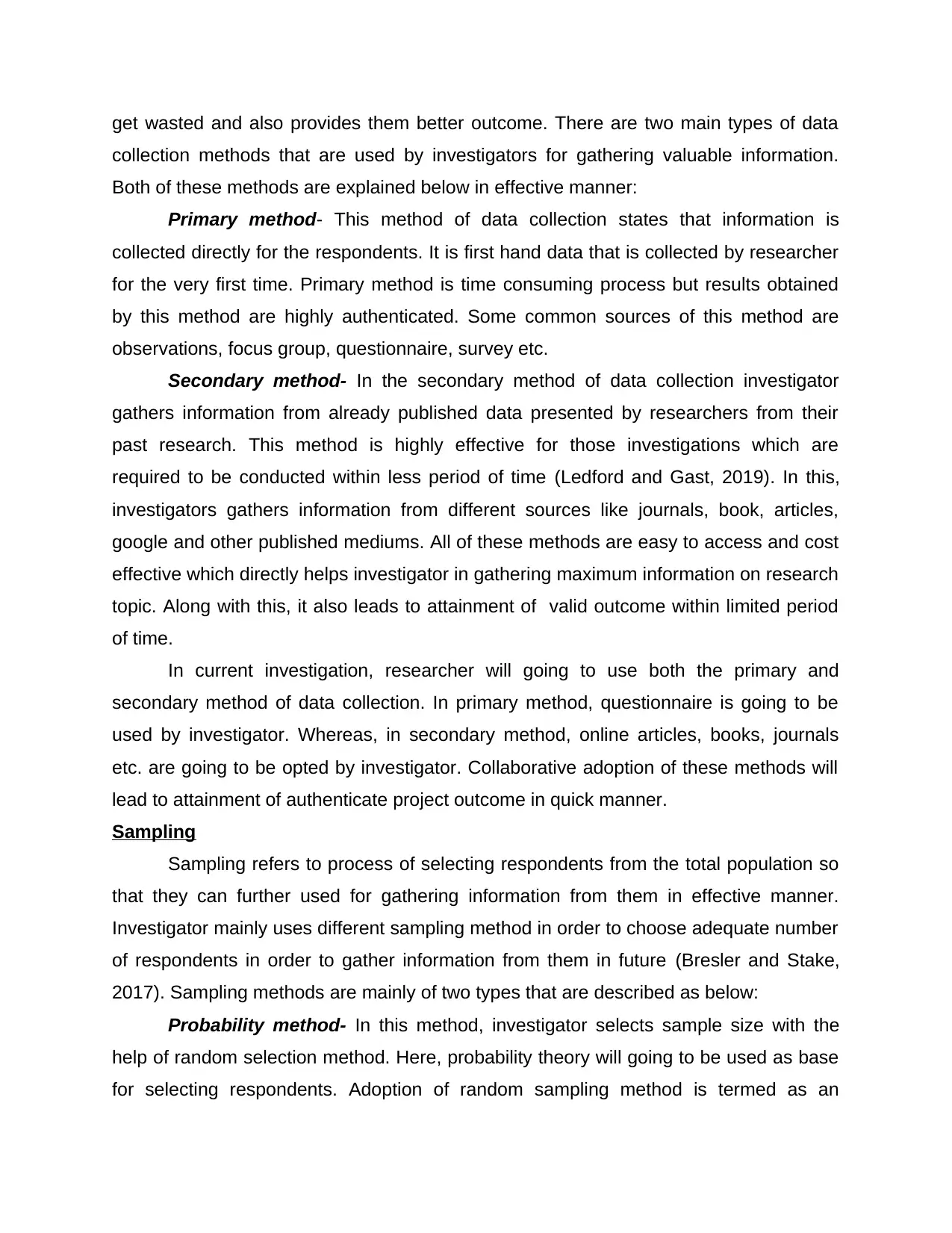
get wasted and also provides them better outcome. There are two main types of data
collection methods that are used by investigators for gathering valuable information.
Both of these methods are explained below in effective manner:
Primary method- This method of data collection states that information is
collected directly for the respondents. It is first hand data that is collected by researcher
for the very first time. Primary method is time consuming process but results obtained
by this method are highly authenticated. Some common sources of this method are
observations, focus group, questionnaire, survey etc.
Secondary method- In the secondary method of data collection investigator
gathers information from already published data presented by researchers from their
past research. This method is highly effective for those investigations which are
required to be conducted within less period of time (Ledford and Gast, 2019). In this,
investigators gathers information from different sources like journals, book, articles,
google and other published mediums. All of these methods are easy to access and cost
effective which directly helps investigator in gathering maximum information on research
topic. Along with this, it also leads to attainment of valid outcome within limited period
of time.
In current investigation, researcher will going to use both the primary and
secondary method of data collection. In primary method, questionnaire is going to be
used by investigator. Whereas, in secondary method, online articles, books, journals
etc. are going to be opted by investigator. Collaborative adoption of these methods will
lead to attainment of authenticate project outcome in quick manner.
Sampling
Sampling refers to process of selecting respondents from the total population so
that they can further used for gathering information from them in effective manner.
Investigator mainly uses different sampling method in order to choose adequate number
of respondents in order to gather information from them in future (Bresler and Stake,
2017). Sampling methods are mainly of two types that are described as below:
Probability method- In this method, investigator selects sample size with the
help of random selection method. Here, probability theory will going to be used as base
for selecting respondents. Adoption of random sampling method is termed as an
collection methods that are used by investigators for gathering valuable information.
Both of these methods are explained below in effective manner:
Primary method- This method of data collection states that information is
collected directly for the respondents. It is first hand data that is collected by researcher
for the very first time. Primary method is time consuming process but results obtained
by this method are highly authenticated. Some common sources of this method are
observations, focus group, questionnaire, survey etc.
Secondary method- In the secondary method of data collection investigator
gathers information from already published data presented by researchers from their
past research. This method is highly effective for those investigations which are
required to be conducted within less period of time (Ledford and Gast, 2019). In this,
investigators gathers information from different sources like journals, book, articles,
google and other published mediums. All of these methods are easy to access and cost
effective which directly helps investigator in gathering maximum information on research
topic. Along with this, it also leads to attainment of valid outcome within limited period
of time.
In current investigation, researcher will going to use both the primary and
secondary method of data collection. In primary method, questionnaire is going to be
used by investigator. Whereas, in secondary method, online articles, books, journals
etc. are going to be opted by investigator. Collaborative adoption of these methods will
lead to attainment of authenticate project outcome in quick manner.
Sampling
Sampling refers to process of selecting respondents from the total population so
that they can further used for gathering information from them in effective manner.
Investigator mainly uses different sampling method in order to choose adequate number
of respondents in order to gather information from them in future (Bresler and Stake,
2017). Sampling methods are mainly of two types that are described as below:
Probability method- In this method, investigator selects sample size with the
help of random selection method. Here, probability theory will going to be used as base
for selecting respondents. Adoption of random sampling method is termed as an
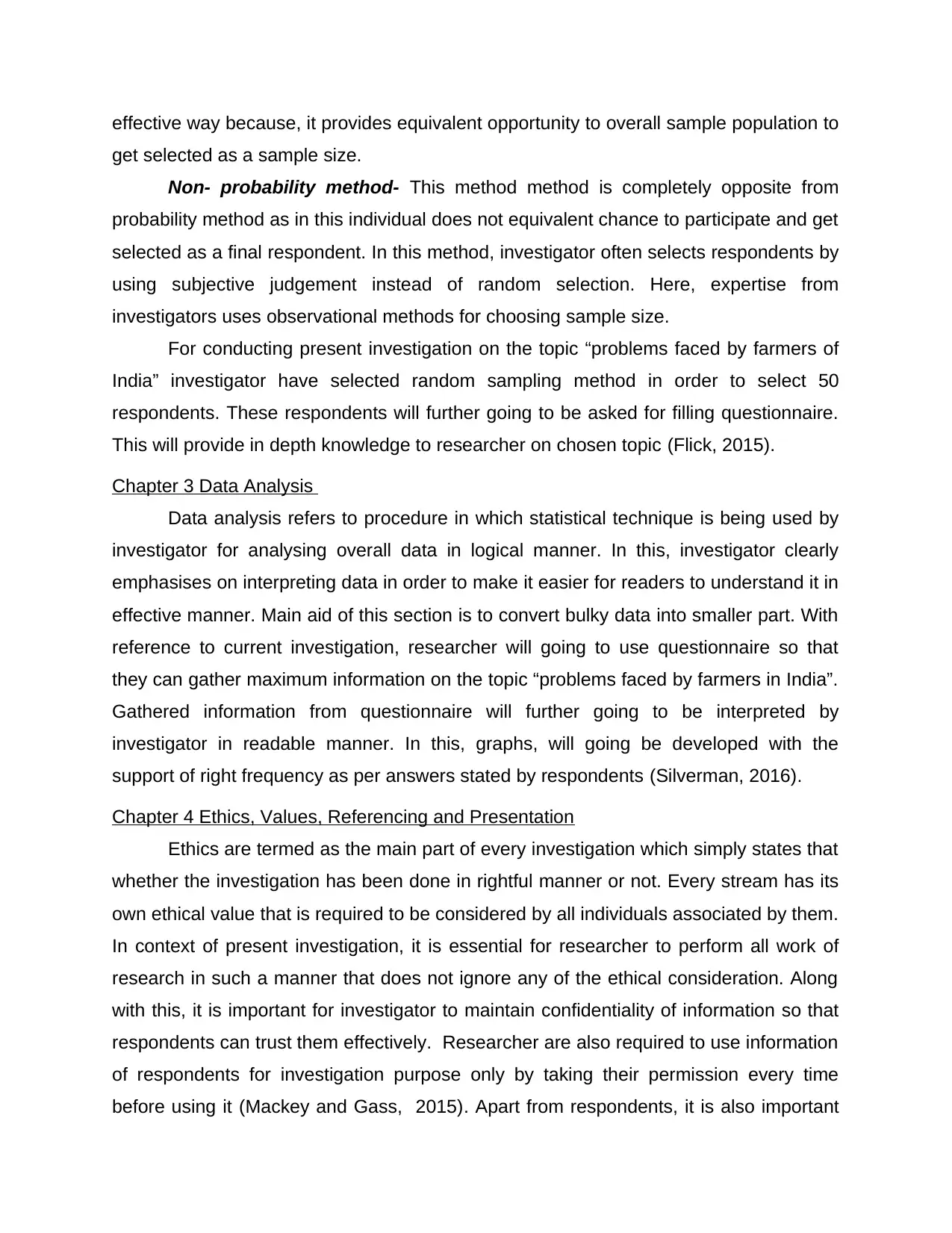
effective way because, it provides equivalent opportunity to overall sample population to
get selected as a sample size.
Non- probability method- This method method is completely opposite from
probability method as in this individual does not equivalent chance to participate and get
selected as a final respondent. In this method, investigator often selects respondents by
using subjective judgement instead of random selection. Here, expertise from
investigators uses observational methods for choosing sample size.
For conducting present investigation on the topic “problems faced by farmers of
India” investigator have selected random sampling method in order to select 50
respondents. These respondents will further going to be asked for filling questionnaire.
This will provide in depth knowledge to researcher on chosen topic (Flick, 2015).
Chapter 3 Data Analysis
Data analysis refers to procedure in which statistical technique is being used by
investigator for analysing overall data in logical manner. In this, investigator clearly
emphasises on interpreting data in order to make it easier for readers to understand it in
effective manner. Main aid of this section is to convert bulky data into smaller part. With
reference to current investigation, researcher will going to use questionnaire so that
they can gather maximum information on the topic “problems faced by farmers in India”.
Gathered information from questionnaire will further going to be interpreted by
investigator in readable manner. In this, graphs, will going be developed with the
support of right frequency as per answers stated by respondents (Silverman, 2016).
Chapter 4 Ethics, Values, Referencing and Presentation
Ethics are termed as the main part of every investigation which simply states that
whether the investigation has been done in rightful manner or not. Every stream has its
own ethical value that is required to be considered by all individuals associated by them.
In context of present investigation, it is essential for researcher to perform all work of
research in such a manner that does not ignore any of the ethical consideration. Along
with this, it is important for investigator to maintain confidentiality of information so that
respondents can trust them effectively. Researcher are also required to use information
of respondents for investigation purpose only by taking their permission every time
before using it (Mackey and Gass, 2015). Apart from respondents, it is also important
get selected as a sample size.
Non- probability method- This method method is completely opposite from
probability method as in this individual does not equivalent chance to participate and get
selected as a final respondent. In this method, investigator often selects respondents by
using subjective judgement instead of random selection. Here, expertise from
investigators uses observational methods for choosing sample size.
For conducting present investigation on the topic “problems faced by farmers of
India” investigator have selected random sampling method in order to select 50
respondents. These respondents will further going to be asked for filling questionnaire.
This will provide in depth knowledge to researcher on chosen topic (Flick, 2015).
Chapter 3 Data Analysis
Data analysis refers to procedure in which statistical technique is being used by
investigator for analysing overall data in logical manner. In this, investigator clearly
emphasises on interpreting data in order to make it easier for readers to understand it in
effective manner. Main aid of this section is to convert bulky data into smaller part. With
reference to current investigation, researcher will going to use questionnaire so that
they can gather maximum information on the topic “problems faced by farmers in India”.
Gathered information from questionnaire will further going to be interpreted by
investigator in readable manner. In this, graphs, will going be developed with the
support of right frequency as per answers stated by respondents (Silverman, 2016).
Chapter 4 Ethics, Values, Referencing and Presentation
Ethics are termed as the main part of every investigation which simply states that
whether the investigation has been done in rightful manner or not. Every stream has its
own ethical value that is required to be considered by all individuals associated by them.
In context of present investigation, it is essential for researcher to perform all work of
research in such a manner that does not ignore any of the ethical consideration. Along
with this, it is important for investigator to maintain confidentiality of information so that
respondents can trust them effectively. Researcher are also required to use information
of respondents for investigation purpose only by taking their permission every time
before using it (Mackey and Gass, 2015). Apart from respondents, it is also important
⊘ This is a preview!⊘
Do you want full access?
Subscribe today to unlock all pages.

Trusted by 1+ million students worldwide
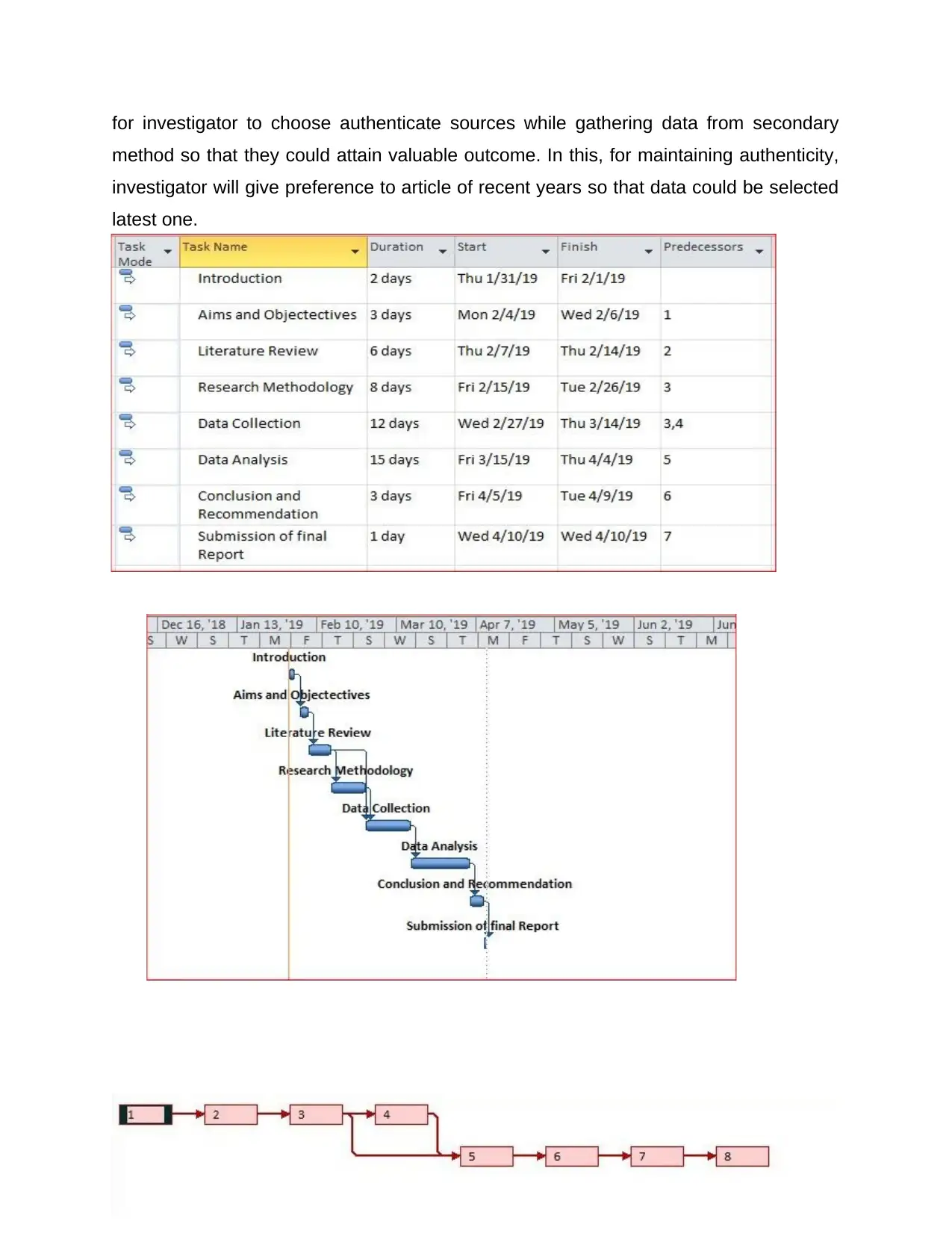
for investigator to choose authenticate sources while gathering data from secondary
method so that they could attain valuable outcome. In this, for maintaining authenticity,
investigator will give preference to article of recent years so that data could be selected
latest one.
method so that they could attain valuable outcome. In this, for maintaining authenticity,
investigator will give preference to article of recent years so that data could be selected
latest one.
Paraphrase This Document
Need a fresh take? Get an instant paraphrase of this document with our AI Paraphraser
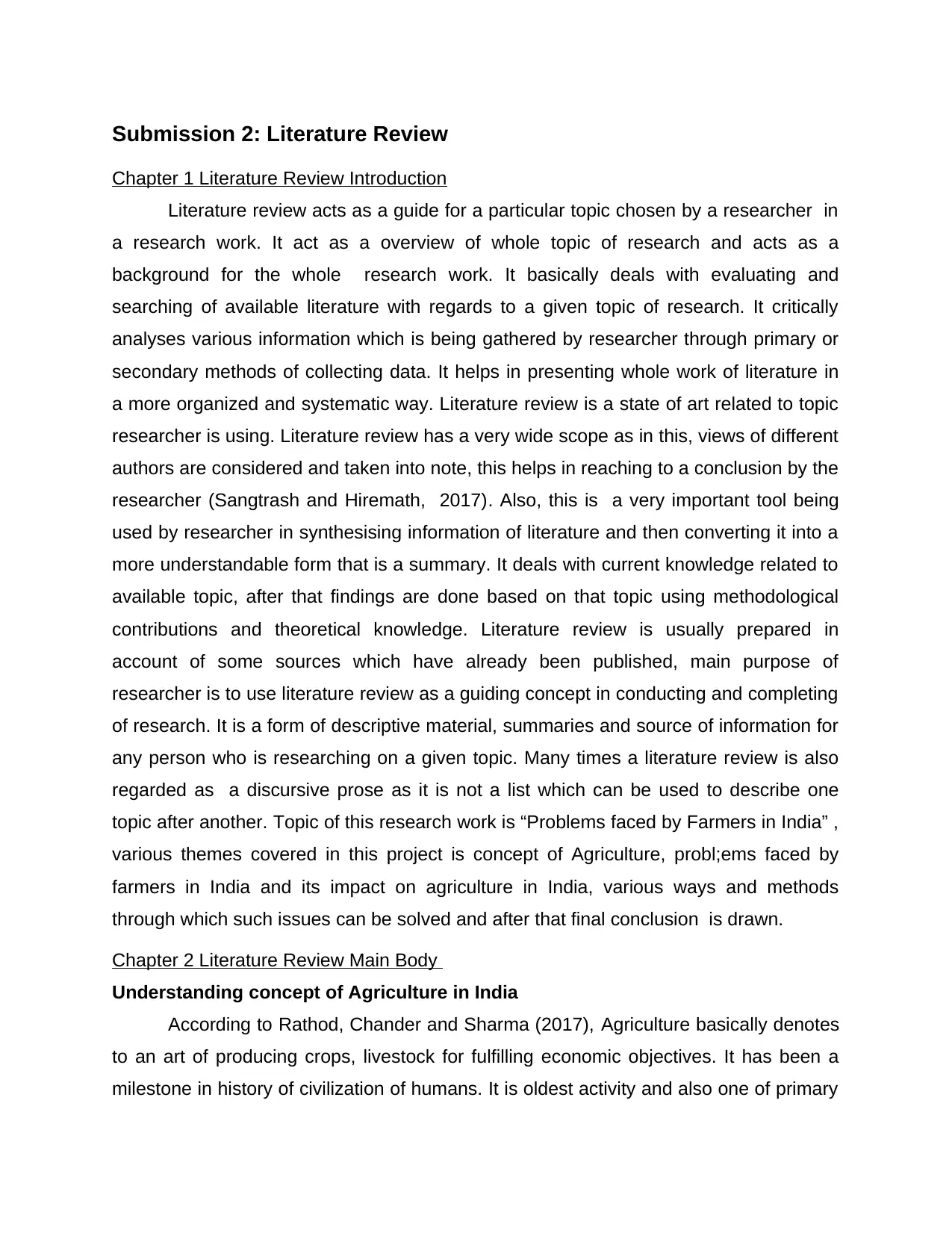
Submission 2: Literature Review
Chapter 1 Literature Review Introduction
Literature review acts as a guide for a particular topic chosen by a researcher in
a research work. It act as a overview of whole topic of research and acts as a
background for the whole research work. It basically deals with evaluating and
searching of available literature with regards to a given topic of research. It critically
analyses various information which is being gathered by researcher through primary or
secondary methods of collecting data. It helps in presenting whole work of literature in
a more organized and systematic way. Literature review is a state of art related to topic
researcher is using. Literature review has a very wide scope as in this, views of different
authors are considered and taken into note, this helps in reaching to a conclusion by the
researcher (Sangtrash and Hiremath, 2017). Also, this is a very important tool being
used by researcher in synthesising information of literature and then converting it into a
more understandable form that is a summary. It deals with current knowledge related to
available topic, after that findings are done based on that topic using methodological
contributions and theoretical knowledge. Literature review is usually prepared in
account of some sources which have already been published, main purpose of
researcher is to use literature review as a guiding concept in conducting and completing
of research. It is a form of descriptive material, summaries and source of information for
any person who is researching on a given topic. Many times a literature review is also
regarded as a discursive prose as it is not a list which can be used to describe one
topic after another. Topic of this research work is “Problems faced by Farmers in India” ,
various themes covered in this project is concept of Agriculture, probl;ems faced by
farmers in India and its impact on agriculture in India, various ways and methods
through which such issues can be solved and after that final conclusion is drawn.
Chapter 2 Literature Review Main Body
Understanding concept of Agriculture in India
According to Rathod, Chander and Sharma (2017), Agriculture basically denotes
to an art of producing crops, livestock for fulfilling economic objectives. It has been a
milestone in history of civilization of humans. It is oldest activity and also one of primary
Chapter 1 Literature Review Introduction
Literature review acts as a guide for a particular topic chosen by a researcher in
a research work. It act as a overview of whole topic of research and acts as a
background for the whole research work. It basically deals with evaluating and
searching of available literature with regards to a given topic of research. It critically
analyses various information which is being gathered by researcher through primary or
secondary methods of collecting data. It helps in presenting whole work of literature in
a more organized and systematic way. Literature review is a state of art related to topic
researcher is using. Literature review has a very wide scope as in this, views of different
authors are considered and taken into note, this helps in reaching to a conclusion by the
researcher (Sangtrash and Hiremath, 2017). Also, this is a very important tool being
used by researcher in synthesising information of literature and then converting it into a
more understandable form that is a summary. It deals with current knowledge related to
available topic, after that findings are done based on that topic using methodological
contributions and theoretical knowledge. Literature review is usually prepared in
account of some sources which have already been published, main purpose of
researcher is to use literature review as a guiding concept in conducting and completing
of research. It is a form of descriptive material, summaries and source of information for
any person who is researching on a given topic. Many times a literature review is also
regarded as a discursive prose as it is not a list which can be used to describe one
topic after another. Topic of this research work is “Problems faced by Farmers in India” ,
various themes covered in this project is concept of Agriculture, probl;ems faced by
farmers in India and its impact on agriculture in India, various ways and methods
through which such issues can be solved and after that final conclusion is drawn.
Chapter 2 Literature Review Main Body
Understanding concept of Agriculture in India
According to Rathod, Chander and Sharma (2017), Agriculture basically denotes
to an art of producing crops, livestock for fulfilling economic objectives. It has been a
milestone in history of civilization of humans. It is oldest activity and also one of primary
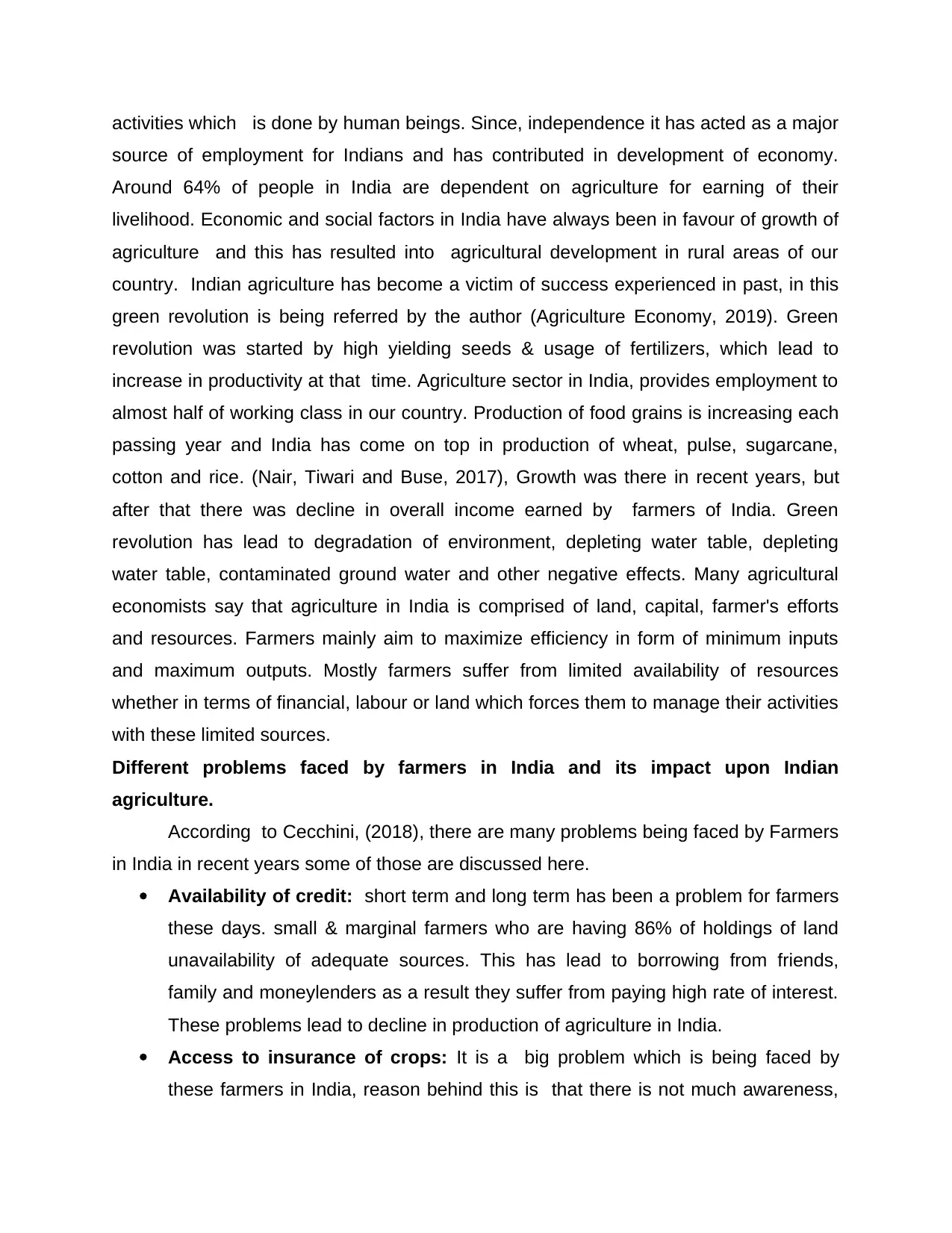
activities which is done by human beings. Since, independence it has acted as a major
source of employment for Indians and has contributed in development of economy.
Around 64% of people in India are dependent on agriculture for earning of their
livelihood. Economic and social factors in India have always been in favour of growth of
agriculture and this has resulted into agricultural development in rural areas of our
country. Indian agriculture has become a victim of success experienced in past, in this
green revolution is being referred by the author (Agriculture Economy, 2019). Green
revolution was started by high yielding seeds & usage of fertilizers, which lead to
increase in productivity at that time. Agriculture sector in India, provides employment to
almost half of working class in our country. Production of food grains is increasing each
passing year and India has come on top in production of wheat, pulse, sugarcane,
cotton and rice. (Nair, Tiwari and Buse, 2017), Growth was there in recent years, but
after that there was decline in overall income earned by farmers of India. Green
revolution has lead to degradation of environment, depleting water table, depleting
water table, contaminated ground water and other negative effects. Many agricultural
economists say that agriculture in India is comprised of land, capital, farmer's efforts
and resources. Farmers mainly aim to maximize efficiency in form of minimum inputs
and maximum outputs. Mostly farmers suffer from limited availability of resources
whether in terms of financial, labour or land which forces them to manage their activities
with these limited sources.
Different problems faced by farmers in India and its impact upon Indian
agriculture.
According to Cecchini, (2018), there are many problems being faced by Farmers
in India in recent years some of those are discussed here.
Availability of credit: short term and long term has been a problem for farmers
these days. small & marginal farmers who are having 86% of holdings of land
unavailability of adequate sources. This has lead to borrowing from friends,
family and moneylenders as a result they suffer from paying high rate of interest.
These problems lead to decline in production of agriculture in India.
Access to insurance of crops: It is a big problem which is being faced by
these farmers in India, reason behind this is that there is not much awareness,
source of employment for Indians and has contributed in development of economy.
Around 64% of people in India are dependent on agriculture for earning of their
livelihood. Economic and social factors in India have always been in favour of growth of
agriculture and this has resulted into agricultural development in rural areas of our
country. Indian agriculture has become a victim of success experienced in past, in this
green revolution is being referred by the author (Agriculture Economy, 2019). Green
revolution was started by high yielding seeds & usage of fertilizers, which lead to
increase in productivity at that time. Agriculture sector in India, provides employment to
almost half of working class in our country. Production of food grains is increasing each
passing year and India has come on top in production of wheat, pulse, sugarcane,
cotton and rice. (Nair, Tiwari and Buse, 2017), Growth was there in recent years, but
after that there was decline in overall income earned by farmers of India. Green
revolution has lead to degradation of environment, depleting water table, depleting
water table, contaminated ground water and other negative effects. Many agricultural
economists say that agriculture in India is comprised of land, capital, farmer's efforts
and resources. Farmers mainly aim to maximize efficiency in form of minimum inputs
and maximum outputs. Mostly farmers suffer from limited availability of resources
whether in terms of financial, labour or land which forces them to manage their activities
with these limited sources.
Different problems faced by farmers in India and its impact upon Indian
agriculture.
According to Cecchini, (2018), there are many problems being faced by Farmers
in India in recent years some of those are discussed here.
Availability of credit: short term and long term has been a problem for farmers
these days. small & marginal farmers who are having 86% of holdings of land
unavailability of adequate sources. This has lead to borrowing from friends,
family and moneylenders as a result they suffer from paying high rate of interest.
These problems lead to decline in production of agriculture in India.
Access to insurance of crops: It is a big problem which is being faced by
these farmers in India, reason behind this is that there is not much awareness,
⊘ This is a preview!⊘
Do you want full access?
Subscribe today to unlock all pages.

Trusted by 1+ million students worldwide
1 out of 19
Related Documents
Your All-in-One AI-Powered Toolkit for Academic Success.
+13062052269
info@desklib.com
Available 24*7 on WhatsApp / Email
![[object Object]](/_next/static/media/star-bottom.7253800d.svg)
Unlock your academic potential
Copyright © 2020–2025 A2Z Services. All Rights Reserved. Developed and managed by ZUCOL.




